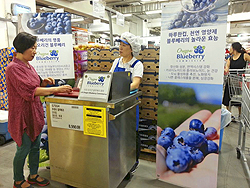Korean Market Exploration Finds Potential for Increasing Sales
Hoping to increase fresh blueberry exports to South Korea, the Oregon Blueberry Commission brought a four-member team to the Asian country this past April.
“The market has not expanded like we had anticipated,” said Commission Administrator Bryan Ostlund, “so we are trying to better understand the market.”
The team included Ostlund, an Oregon packer, a contract marketer and a representative from the Oregon Department of Agriculture. The trip was funded by a USDA Specialty Crop Block Grant.
The team met with buyers, retailers and government officials during five days on the ground in Korea. “We told them what we were doing, looked at their sales forecasts and asked them questions, such as what support would be helpful from us and how are we doing with our price points with the type of quality we are shipping. We got their feedback on what it is they want and how we can do things better,” Ostlund said.
 Sales of Oregon fresh blueberries in South Korea came out of the gate strong when Korea opened their market eight years ago. The state shipped roughly 600,000 pounds to South Korea that first year. Sales volume peaked at around 1.5 million pounds before pulling back to around 1 million pounds in recent years.
Sales of Oregon fresh blueberries in South Korea came out of the gate strong when Korea opened their market eight years ago. The state shipped roughly 600,000 pounds to South Korea that first year. Sales volume peaked at around 1.5 million pounds before pulling back to around 1 million pounds in recent years.
Ostlund attributed the decline and subsequent stagnation in sales volume to an improvement in the sophistication of Korea’s domestic industry.
“They have been producing blueberries for quite a while, but not at the level of sophistication that they are now,” Ostlund said. “Now they are operating at a high level. They are doing a very nice job and they have displaced some of our early-season fruit sales.”
He noted that Korean consumers prize jumbo-sized blueberries that are crisp and flavorful. “It is a different way of thinking about things compared to what we typically see in North America,” he said. “We can produce some of that bigger fruit, but it is a challenge, especially when you are selling it in the smaller clamshells. It almost requires different packaging.”
Still, Ostlund said he sees opportunities to pull market share from the Korean domestic production and to increase exports above current levels in the weeks and months after Korea’s fresh market season concludes. And, according to Ostlund and Eric Rosenberg of the Seattle-based marketing firm Bryant Christie, who was part of the entourage, Korean retailers indicated as much.
“(Korean buyers) were expressing interest to see if Oregon could start shipping in late June,” Rosenberg said, about two weeks prior to the conclusion of the Korean fresh market production season.
“Certainly, their retailers are supportive of their local industry, but their local industry does not produce the volumes that are capable of satisfying the marketplace and their prices are high,” Rosenberg said.
As for late-season opportunities, Rosenberg and Ostlund characterized them as excellent, particularly if in-store and electronic promotions, funded in part by the Specialty Crop Block Grant, increase consumption levels among Korean consumers.
“Hopefully we will see sales increase,” Ostlund said. He noted that a mid-year report for 2019 showed Oregon sales volume to South Korea 19 percent ahead of last year. “Early indications are strong,” he said. “We don’t want to get ahead of ourselves, but as long as those trends continue, it is looking good.”
Currently, Oregon is the only state allowed to ship fresh blueberries to South Korea. Growers and packers who do so meet strict systems-based protocols that include trapping for pests, extensive documentation and third-party monitoring of operations. Currently about five packers and a dozen growers are participating in the Korean export program.
Ostlund noted that California and Washington also have applied to enter the fresh blueberry market in South Korea. He couldn’t say how close they are to gaining access. “I don’t think anybody knows,” he said. “It could be ten years. It could be next year.”